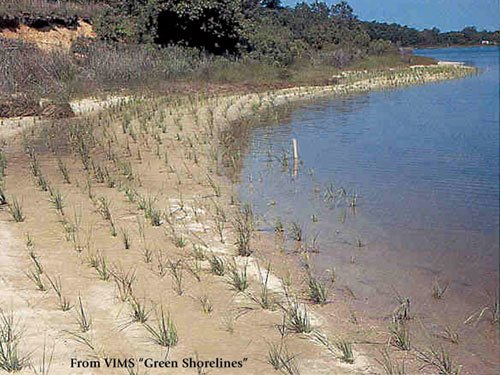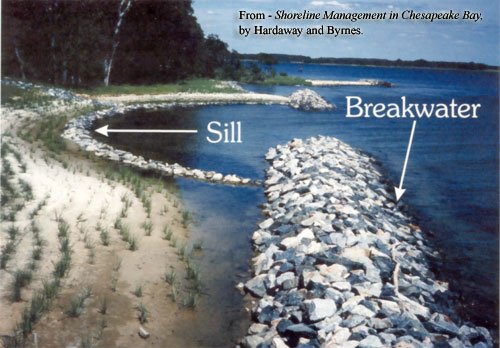
Conservation Landscaping
Introduction
Our landscapes and shorelines can either contribute to resilience—becoming part of the solution—or exacerbate issues such as wetland loss, water pollution, flooding, sea level rise, and habitat degradation.
Conservation landscapes align with nature by integrating environmental site design, low-impact development, native and beneficial plant species, and integrated pest management to create diverse, resilient environments.
These landscapes not only protect clean air and water, but also support wildlife and enhance human well-being by fostering healthier, more beautiful surroundings.
By incorporating natural and nature-based solutions, conservation landscapes enhance the connectivity of our green infrastructure, both in upland areas and along shorelines. Techniques such as living shorelines, native plant buffers, rain gardens, green roofs, cisterns, permeable pavement, and eco-friendly lawns reduce the reliance on fertilizers and increase the presence of native species, creating more sustainable and adaptable environments.
Natural Shoreline Erosion Protection Measures
Waterfront properties vary widely in their characteristics—some are tucked away in sheltered coves or small creeks, while others are exposed to open waters and strong wave action. While some properties experience steady erosion, others remain stable or even gain land. For decades, however, shoreline protection methods have largely followed a “one-size-fits-all” approach, often relying on bulkheads or rock (riprap) revetments to address erosion.
Over the past couple decades, we have gained a deeper understanding of the factors that contribute to a healthy ecosystem. Studies have shown that hardened shorelines, such as bulkheads and rock revetments, can lead to lower populations of bottom-dwelling organisms and fewer juvenile fish and crabs compared to shorelines with vegetated marshes.
Living Shorelines
For many waterfront areas exposed to low to moderate wave energy, effective alternatives to shoreline hardening exist. These approaches, often referred to as “soft” or “living” shoreline techniques, offer numerous benefits over traditional methods:
Lower construction costs compared to bulkheads and revetments
Reduction of sediment and pollutant runoff into creeks or rivers
Preservation of the natural connection between aquatic and upland habitats
A more natural and visually appealing shoreline
Restoration or maintenance of vital spawning and nursery habitats for fish, crabs, and other wildlife
Living shorelines offer an environmentally friendly and long-term solution to erosion, while also supporting habitat and water quality improvement.
Living Shorelines as Default Option in Virginia
In 2010, the Virginia Institute of Marine Sciences delivered a report to the Virginia General Assembly on the value of living shorelines. This report resulted in a 2011 law that sets living shorelines as the preferred option for shoreline erosion control and sets up a general permit for living shorelines in Virginia. Updates to the Code of Virginia enacted in 2020 established living shorelines as the required approach for shoreline erosion control.
Non-Structural Approach
Shorelines in creeks or coves that experience low-energy wave action can often be protected without the use of hard structures. Techniques such as replanting wetland vegetation or beach replenishment are effective in these environments. These methods are most appropriate if the property once supported a vegetated wetland or beach, or if neighboring shorelines feature similar natural characteristics.
Hybrid Approaches
In areas with higher wave exposure, it is often still possible to preserve a predominantly natural shoreline through the use of hybrid techniques. Three common structural additions for this purpose include nearshore and offshore breakwaters, sills, and low-profile rock groins. Unlike bulkheads and revetments, which are designed to reflect or absorb wave energy, these
structures are placed in the intertidal zone or beyond the low tide mark to encourage sand accumulation along the shoreline. Typically, they are used in combination with beach replenishment and marsh plantings to further stabilize the shoreline and enhance natural habitat restoration
Resources containing greater detail about Living Shorelines:
Living Shorelines Website - Virginia Institute of Marine Science (VIMS)
Shore Erosion Control: The Natural Approach - Eastern Shore Maryland Resource Conservation & Development
Native Plants and Wetland-Friendly Landscapes
Native plants are species that have evolved and naturally adapted to the specific conditions of a region, such as its climate, soils, and pests. Because of this, they are easier to grow and require minimal maintenance, reducing the need for excessive watering, fertilizers, and pesticides. Native plants help reduce pollutants being carried by runoff into wetlands and waterways.
Additionally, planting native species along property borders can serve as a buffer, slowing water runoff (which helps prevent erosion) and acting as a natural filter to remove pollutants before they reach sensitive aquatic environments.
Incorporating native plants into landscapes and buffer zones offers another important benefit: they provide wildlife with familiar sources of food, shelter, and breeding sites. As natural habitats are increasingly lost to development, creating spaces with native plants helps maintain biodiversity and supports local ecosystems. The Virginia Institute of Marine Sciences has a valuable resource page on native plants. The Virginia Department of Conservation and Recreation offers a comprehensive description of buying, growing and the benefits of native plants. Additional resources include the Alliance for the Chesapeake Bay’s Bay Scapes program and the Chesapeake Conservation Landscaping Council.
As awareness of the benefits of native plants grows, they have become more widely available at local nurseries and home improvement stores. It is essential to choose nursery-propagated plants rather than those collected from the wild to help protect and preserve natural populations from depletion.
Please consult the native plant guide for Southeast Virginia below.
OTHER LANDSCAPING TIPS
Allow native marsh grasses and wetland plants to grow between your lawn and waterways. Do not mow marsh grass or cut down wetland plants or shrubs, like salt bush.
Minimize the amount of paved surfaces in your yard to decrease runoff. Consider using mulch, stepping stones or bricks on sand for walkways or patios.
Enjoy a low-maintenance, low-cost yard by keeping grass lawns small and using no-maintenance ground covers where possible.
Use a mulching lawn mower that recycles lawn clippings, restores nutrients to the soil, and reduces landfill waste.
Mow higher, no less than 3 inches, and less frequently.
Insist on a lawn care company that uses only organic fertilizers and natural pest management techniques.
Aerate lawn to decrease compaction and remove thatch.
When planning protection for your shoreline against erosion, consider natural methods like planting a fringe marsh, rather than “hardening” the shoreline, which may not be necessary. For more, check the Virginia Institute of Marine Science Living Shorelines resource page.
Consider a rain garden to slow and pool water so it soaks into the ground and filters runoff, instead of rushing into the wetland area in the back yard. Learn more from the James River Association’s Rain Garden Installation Guide.
Install a rain barrel to capture roof runoff for reuse. See Alliance for the Chesapeake Bay's rain barrel planning and installation guide.
Avoid planting invasive plants. Learn which plants are invasive and how they impact your environment.





